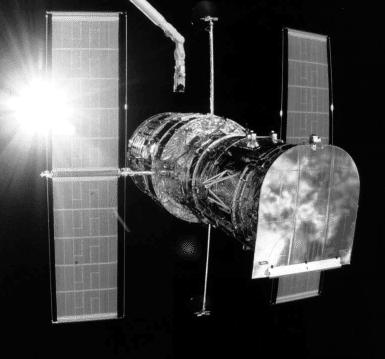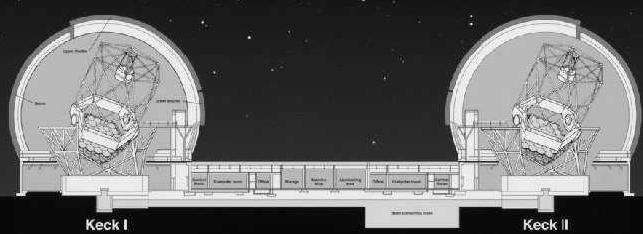Hubble Compared with New Ground-Based Optical Telescopes
From a NASA Fact Sheet
The Hubble Space Telescope (HST) represents a historic leap forward for optical and ultraviolet astronomy. However, the aberration in the HST's
primary mirror led many to claim that powerful new ground-based telescopes will equal or surpass HST's performance. On the other hand, when optically corrected after the Servicing Mission in late 1993, the sensitivity of HST to very faint objects increased by about 10 times. Each type of telescope offers astronomers unique strengths. Astronomy will make its mark on history with a combination of advanced ground-based systems and the Hubble Space Telescope.

Two features of telescope design are crucial in comparing the capability of ground-based telescopes: resolving power and light gathering power. Location also is a key factor which in many cases outweighs the differences in resolving power and light gathering power of telescopes.
Light Gathering Power
One measure of a telescope's capability is light gathering power. The bigger the area of a lens or mirror, the more light from an object that can be captured and focused to make a brighter image. For cameras, it's the f-stop which controls how much area of the lens is available: The more area (lower f-numbers), the shorter the exposure needs to be to form an image. Because astronomers study very faint objects in the sky, they need telescopes with as big an area as possible to collect and concentrate light into an image.
The most light-hungry instruments are the spectroscopes which take the incoming light and split it into an array, like colors of the rainbow, called a spectrum. With these spectra scientists can tell what kinds of atoms and molecules are found at very great distances or far back in time and how hot and how fast they are moving.
The world's largest telescope, the W.M. Keck telescope in Mauna Kea, Hawaii, instead of one mirror, is made of many individually controlled, hexagonal mirror segments. Keck's multi-mirror array has a 10-meter (33-foot) aperture. This colossus has 17 times more light collecting area than HST's 2.4-meter (7-foot) mirror. Consequently, Keck's "light bucket" is significantly faster at collecting faint starlight. This makes the Keck telescope a powerful instrument for performing spectroscopic studies of faint objects; it could gather spectral data from astronomical sources much more quickly than Hubble.

Resolving Power
Resolving power or resolution is the ability to yield sharp, detailed images. An optometrist calls this "visual acuity". In theory, a telescope's resolving power improves as the diameter of the telescope's mirror or lens increases. However, the blurring of starlight by Earth's atmosphere prevents telescopes from realizing their theoretical potential.
Ground-based telescopes can resolve detail about 60 times better than the human eye. Keck's larger mirror array is limited by the atmosphere to a resolving power of about .5 arc second. HST, located high above the Earth's atmosphere, has a resolving power that is 5-10 times better. This means that the HST can concentrate starlight into much smaller spots and separate objects that are much closer together than the Keck can.
Although HST will remain the premier observatory for high resolution studies of astronomical objects, new techniques are being used with ground-based telescopes that will allow them to compete with HST even in resolving power. However, these techniques only work for bright star-like objects. They also work only for small patches of sky, a few arc seconds across, near the center of the telescope's field of view. This means that these techniques will not work for studies of extended targets such as star-forming nebulae.
Active Optics, Adaptive Optics
If you look at a star on any clear night, it appears to twinkle. Light from the star passing through the turbulent atmosphere is shifted slightly by parcels of air moving to and fro thousands of times per second. By the time the light reaches the eye, or the telescope, the dancing of the light causes the image to blur into a spot about one arc second wide.
New technologies can sharpen these stellar images by distorting a telescope's mirror to compensate for blurring, or by extracting the blurring later using image processing. In active optics, the shape of the telescope mirror is adjusted hundreds of times per second to cancel the distortions caused by the atmosphere. In adaptive optics, the telescope mirror is moved thousands more times per second to follow the dancing image of the star and keep it focused into a small spot. This technique requires a reference source, either a bright star located in the vicinity of the celestial target or an "artificial star" created by reflecting a laser off selected layers in the atmosphere.
By contrast, Hubble's images and other data are optically stable so astronomers can revisit a target at any time of year and expect the same quality data. This assures a repeatability that is not possible with adaptive optics on ground-based telescopes. An enormously complex ground-based system would be required to match HST performance. Such a system does not currently exist, and could be a decade away - beyond the working lifetime of HST.
Speckle Interferometry
By taking many short exposures in succession rather than one long-time exposure, the effects of atmospheric turbulence can be "frozen." A computer combines each image by shifting it to a common center. This subtracts the blurring effects and recovers the telescope's best resolving power. For ground-based Mt. Palomar's 200-inch mirror this is an improvement from 0.4- at best to 0.02-arc seconds.
Location
Because HST is a space-based observatory, it is the only telescope that can view any celestial target located anywhere in the sky unhindered by either the Earth, Moon or Sun. Keck is located at an ideal observing spot near Earth's equator, allowing it to observe most of the celestial sphere. However, stars and galaxies located near the north and south celestial poles (below 30 degrees altitude from Hawaii) are inaccessible.
Space-based Ultraviolet Astronomy >
The ultraviolet region is a gold mine. The most common elements in the universe - hydrogen, helium, carbon, nitrogen, oxygen and silicon - all leave spectral signatures in the ultraviolet. Ultraviolet light typically radiates from extremely hot, dynamic phenomena, such as cores of active galaxies, quasars, energetic stars, and vast disks of dust around black holes. For those looking through HST's ultraviolet window, a wealth of science about many mysterious sources of energy is open.
A broad range and variety of objects in the universe radiate energy at ultraviolet wavelengths, including the atmospheres of most stars, the surfaces of stars far more massive than our Sun, white dwarfs and hot regions of interstellar gas. However, Earth's atmosphere absorbs almost all the ultraviolet light arriving from other celestial bodies. A telescope in space, equipped for ultraviolet observations, is therefore necessary for the study of objects detectable in this important region of the spectrum. In particular, HST is the most powerful telescope ever launched for ultraviolet astronomy.
Published in the March 1999 issue of the NightTimes




